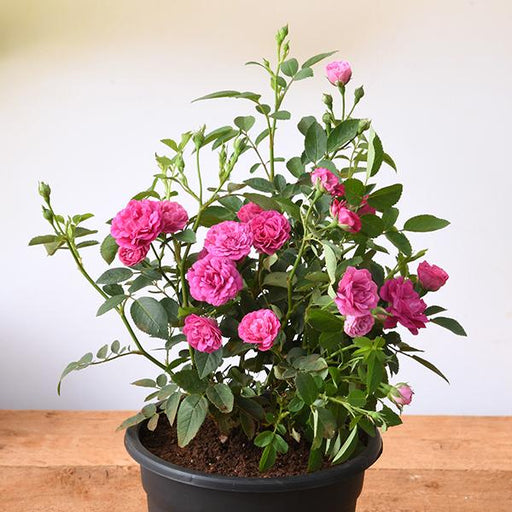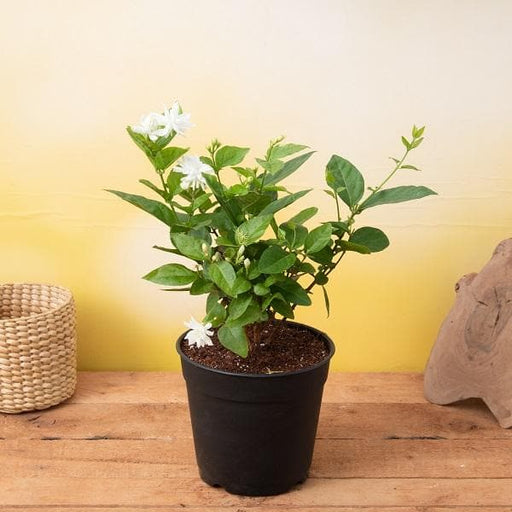
Billbergia pyramidalis concolor - Plant
(MRP Inclusive of all taxes)
- Shipping ₹79 for entire order
- Dispatch in 7 days
- Country of origin: India

(MRP Inclusive of all taxes)
 Save 29%
Save 29%
Air Purifier Money Plant with Pot The Air Purifier Money Plant, also known as Pothos or Epipremnum aureum, is a stunning indoor plant that...
View full details
 Save up to 15%
Save up to 15%
Peace Lily, Spathiphyllum - Plant The Peace Lily, scientifically known as Spathiphyllum, is a stunning houseplant celebrated for its elegant white...
View full details
 Save 25%
Save 25%
Jasminum sambac, Mogra, Arabian Jasmine - Plant Jasminum sambac, commonly known as Mogra or Arabian Jasmine, is a fragrant flowering plant...
View full details
 Save 18%
Save 18%
Combo Constituents Includes the Parijat Tree (Night-Flowering Jasmine), a culturally significant plant with fragrant flowers. Description The Pari...
View full details
 Save 25%
Save 25%
Miniature Rose, Button Rose (Any Color) - Plant The Miniature Rose, also known as the Button Rose, is a charming and compact flowering plant that ...
View full details Save 25%
Save 25%
Damascus Rose, Scented Rose (Any Color) - Plant The Damascus Rose, also known as Rosa damascena, is a timeless symbol of beauty and romanc...
View full details
 Save 17%
Save 17%
Beautiful Fragrant Mogra, Arabian Jasmine Plant with Pot The Beautiful Fragrant Mogra, also known as Arabian Jasmine (Jasminum sambac), is...
View full details Save 15%
Save 15%
Pack of Vermicompost and Neem Cake for House Plants Transform your indoor garden with our premium Pack of Vermicompost and Neem Cake, spec...
View full details
Pack of Plant Growth and Flower Boosters Unlock the full potential of your garden with our Pack of Plant Growth and Flower Boosters! This ...
View full details Save 38%
Save 38%
Combo of Jeevamrut and Neem Raksha for Easy Growth and Protection of Houseplants Transform your indoor garden with our exclusive combo of ...
View full details Save 22%
Save 22%
Plant Nutrients Kit (Pack of 16) for a Healthy Garden Transform your garden into a lush paradise with our Plant Nutrients Kit, featuring 1...
View full details Save 16%
Save 16%
Combo of Top Plant Fertilizers Elevate your gardening game with our exclusive Combo of Top Plant Fertilizers, featuring two bags of premiu...
View full details Save 24%
Save 24%
Pack of 4 Additives to Make Soil Healthy and Nutrient Rich Transform your garden into a thriving ecosystem with our Pack of 4 Additives de...
View full details Save 30%
Save 30%
Transform your gardening experience with our premium Combo of Perlite and Vermiculite. This unique blend is designed to enhance soil aeration and ...
View full details Save 27%
Save 27%
Combo of 2 Vermicompost and Cocopeat - Enrich Your Soil Naturally! Transform your garden into a thriving ecosystem with our Combo of 2 Ver...
View full details
 Save 35%
Save 35%
Best 6 Plants for Perfect Indoor Garden Transform your living space into a lush oasis with our curated collection of the Best 6 Plants for a...
View full details
 Save up to 50%
Save up to 50%
Mini Succulent Garden Pack Transform your space with our Mini Succulent Garden Pack, featuring a delightful collection of 4 any variety beautiful s...
View full details
 Save 30%
Save 30%
5 Best Fragrant Plants Transform your garden or indoor space into a fragrant paradise with our curated selection of the 5 Best Fragrant Plants. Th...
View full details
 Save 24%
Save 24%
Set of 2 Bonsai Looking Grafted Adeniums Transform your indoor or outdoor space with our exquisite Set of 2 Bonsai Looking Grafted Adenium...
View full details Save 45%
Save 45%
Top 4 Die Hard Succulents Pack Transform your indoor or outdoor space with our Top 4 Die Hard Succulents Pack, featuring a curated selecti...
View full details
 Save 30%
Save 30%
5 Best Indoor Plants Pack Transform your living space into a lush oasis with our '5 Best Indoor Plants Pack.' This carefully curated collection fe...
View full details
 Save 25%
Save 25%
Set of 4 Evergreen Air Purifier Plant Pack Transform your indoor space into a lush, green oasis with our Set of 4 Evergreen Air Purifier Pla...
View full details| SrNo | Item Name |
|---|---|
| 1 | Billbergia pyramidalis concolor - Plant |
Billbergia pyramidalis concolor, a stunning bromeliad native to Brazil, is renowned for its striking, colorful inflorescence and unique rosette shape. This perennial plant features long, arching leaves that can reach up to 2 feet in length, creating a dramatic focal point in any garden or indoor space. Its vibrant flowers bloom in shades of pink, red, and yellow, attracting pollinators and adding a tropical flair to your collection.
What makes Billbergia pyramidalis concolor truly special is its adaptability to various environments, thriving in both indoor and outdoor settings. This resilient plant is not only visually appealing but also low-maintenance, making it an ideal choice for both novice and experienced gardeners. Its ability to purify the air further enhances its appeal, contributing positively to your living space.
One of the standout features of this bromeliad is its unique water-holding rosette, which collects rainwater and provides hydration to the plant. This natural reservoir also creates a microhabitat for various beneficial insects, promoting biodiversity in your garden.
Taking care of your Billbergia pyramidalis is like nurturing a diva. This plant demands attention but rewards you with stunning foliage and vibrant blooms. Ensure it gets bright, indirect light and keep the soil moist but not soggy. Remember, it’s a tropical plant, so it enjoys a warm, humid environment. Treat it to a misting session now and then, and it will flourish like the star it is.
Propagating your Billbergia pyramidalis is like playing plant matchmaker. You can do this through offsets, which are the little plantlets that pop up around the base. Gently separate these babies and pot them up in their own cozy homes. With a little patience and the right conditions, you’ll soon have a mini jungle of Billbergia beauties.
This plant is a sun worshipper but with a twist. It prefers bright, indirect light, so think of it as the Goldilocks of the plant world—not too hot, not too cold, but just right. Too much direct sunlight can scorch its leaves, while too little can leave it sulking in the shadows. Find that sweet spot, and your Billbergia will thrive like a superstar.
Watering your Billbergia pyramidalis is an art form. It likes its soil to be consistently moist but not swimming in water. Think of it as giving your plant a refreshing drink rather than a full-on bath. Check the top inch of soil; if it’s dry, it’s time to hydrate. Overwatering can lead to root rot, and nobody wants that drama in their plant life.
The ideal soil for your Billbergia pyramidalis is like a well-balanced diet—light, well-draining, and rich in organic matter. A mix of potting soil, perlite, and orchid bark will do the trick. This combination allows for good drainage while still holding onto some moisture, keeping your plant happy and healthy.
This tropical beauty thrives in warm temperatures, ideally between 65°F and 80°F. It’s not a fan of the cold, so keep it away from chilly drafts or frosty windows. If you want your Billbergia to strut its stuff, make sure it’s cozy and comfortable, just like you would on a lazy Sunday afternoon.
Like any diva, your Billbergia pyramidalis can attract unwanted attention from pests. Watch out for mealybugs and aphids, who think they can crash the party. Regularly inspect your plant and give it a gentle wipe down with a damp cloth. If pests invade, a little neem oil can send them packing.
Feeding your Billbergia pyramidalis is like treating it to a gourmet meal. Use a balanced, water-soluble fertilizer every month during the growing season. This will keep your plant energized and ready to put on a show with its stunning blooms. Just remember, moderation is key—too much fertilizer can lead to a case of the plant equivalent of indigestion.
The bloom time for your Billbergia pyramidalis is like waiting for a surprise party. Typically, it flowers in late spring to early summer, showcasing vibrant, tubular flowers that are sure to steal the spotlight. With the right care, you’ll be rewarded with a floral display that will have your friends green with envy.
Deciding whether to keep your Billbergia pyramidalis indoors or outdoors is like choosing between a cozy night in or a wild night out. Indoors, it can thrive in bright, indirect light, while outdoors, it loves a warm, humid environment. Just make sure to protect it from harsh winds and direct sun. Either way, it’s bound to be the life of the party.
Pairing your Billbergia pyramidalis with the right companions is like assembling the ultimate squad. Consider mixing it with other bromeliads or tropical plants that enjoy similar care. This not only creates a stunning display but also fosters a supportive environment where all your plants can thrive together, sharing the spotlight like true friends.
Good news for pet lovers! Billbergia pyramidalis is non-toxic to cats and dogs, making it a safe choice for your home. You can enjoy its beauty without worrying about your furry friends nibbling on its leaves. Just remember, while it’s safe, it’s still a plant—so maybe don’t let them use it as a chew toy!
Billbergia pyramidalis concolor is a stunning bromeliad known for its vibrant, colorful foliage and unique pyramid-shaped flowers. This plant is a showstopper in any garden, bringing a touch of tropical flair. It’s like the life of the party, but instead of dancing, it just sits there looking fabulous!
Caring for this beauty is a breeze! Just give it bright, indirect light, keep the soil slightly moist, and let it bask in humidity. Think of it as a diva that needs a little pampering but won’t throw a tantrum if you forget to water it once in a while!
Billbergia pyramidalis concolor thrives in well-draining soil, ideally a mix designed for bromeliads. Think of it as a plant that prefers a luxurious spa treatment rather than a muddy swamp. A blend of peat, perlite, and orchid bark will keep it happy and healthy!
Watering this plant is like a fine wine—moderation is key! Water it when the top inch of soil feels dry, but don’t drown it. It enjoys a good drink but hates soggy feet. Aim for a balance, and it’ll reward you with stunning foliage!
Yes, it does! Feed your Billbergia pyramidalis concolor with a balanced liquid fertilizer every month during the growing season. Think of it as giving your plant a gourmet meal. Just don’t overdo it; too much fertilizer can turn your plant into a drama queen!
Absolutely! This plant loves the indoor life as long as it gets enough bright, indirect light. It’s like the ultimate houseguest—charming, low-maintenance, and always ready to brighten up your space. Just make sure it has a cozy spot away from cold drafts!
Keep an eye out for pesky pests like mealybugs and aphids. They’re like uninvited guests at a party, and nobody likes that! If you spot them, a gentle wipe with soapy water or insecticidal soap will send them packing. Your plant deserves a pest-free life!
Good news for pet lovers! Billbergia pyramidalis concolor is non-toxic to cats and dogs. It’s like the friendly neighbor who welcomes your furry friends with open arms. However, it’s always wise to keep an eye on your pets, just in case they decide to munch on the leaves!
Patience is a virtue! Billbergia pyramidalis concolor typically takes about 2-3 years to bloom. It’s like waiting for a fine wine to age—worth the wait! Once it flowers, you’ll be rewarded with a spectacular display that’ll make all the waiting worthwhile.
Yes, you can! Propagation is as easy as pie. Just wait for offsets, or “pups,” to appear around the base of the plant. Once they’re a few inches tall, gently separate them and pot them up. It’s like sharing the love—your plant family will grow in no time!
This tropical beauty prefers temperatures between 60°F and 80°F. It’s like a sunbather that enjoys warm weather but can tolerate a slight chill. Just avoid freezing temperatures, and your plant will thrive like it’s on a permanent vacation!
A healthy Billbergia pyramidalis concolor will have vibrant, firm leaves and a robust growth pattern. If it’s looking droopy or discolored, it might be time for a little TLC. Think of it as your plant’s way of saying, “Hey, I need a little love over here!”